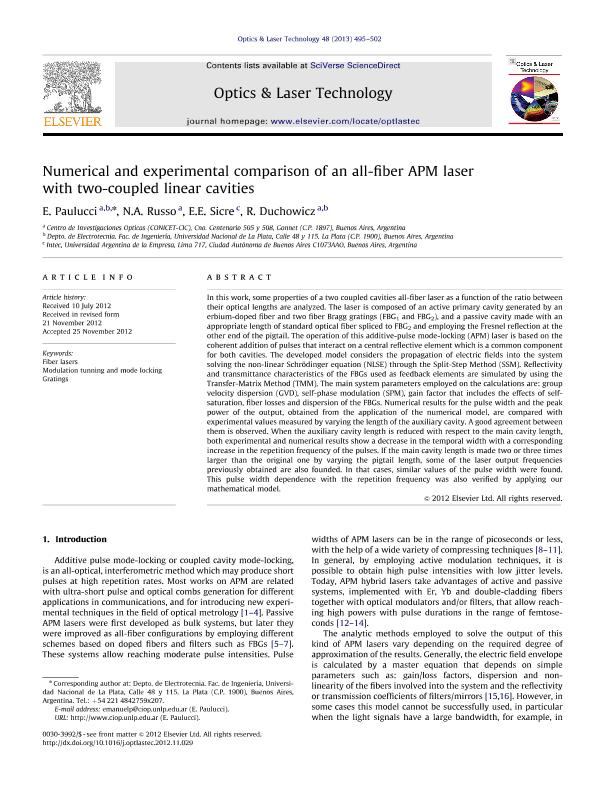Mostrar el registro sencillo del ítem
dc.contributor.author
Paulucci, Emanuel

dc.contributor.author
Russo, Nélida A.
dc.contributor.author
Sicre, Enrique Eduardo

dc.contributor.author
Duchowicz, Ricardo

dc.date.available
2016-09-02T20:23:42Z
dc.date.issued
2013-06
dc.identifier.citation
Paulucci, Emanuel; Russo, Nélida A.; Sicre, Enrique Eduardo; Duchowicz, Ricardo; Numerical and experimental comparison of an all-fiber APM laser with two-coupled linear cavities; Elsevier; Optics and Laser Technology; 48; 6-2013; 495-502
dc.identifier.issn
0030-3992
dc.identifier.uri
http://hdl.handle.net/11336/7412
dc.description.abstract
In this work, some properties of a two coupled cavities all-fiber laser as a function of the ratio between their optical lengths are analyzed. The laser is composed of an active primary cavity generated by an erbium-doped fiber and two fiber Bragg gratings (FBG1 and FBG2), and a passive cavity made with an appropriate length of standard optical fiber spliced to FBG2 and employing the Fresnel reflection at the other end of the pigtail. The operation of this additive-pulse mode-locking (APM) laser is based on the coherent addition of pulses that interact on a central reflective element which is a common component for both cavities. The developed model considers the propagation of electric fields into the system solving the non-linear Schrödinger equation (NLSE) through the Split-Step Method (SSM). Reflectivity and transmittance characteristics of the FBGs used as feedback elements are simulated by using the Transfer-Matrix Method (TMM). The main system parameters employed on the calculations are: group velocity dispersion (GVD), self-phase modulation (SPM), gain factor that includes the effects of self-saturation, fiber losses and dispersion of the FBGs. Numerical results for the pulse width and the peak power of the output, obtained from the application of the numerical model, are compared with experimental values measured by varying the length of the auxiliary cavity. A good agreement between them is observed. When the auxiliary cavity length is reduced with respect to the main cavity length, both experimental and numerical results show a decrease in the temporal width with a corresponding increase in the repetition frequency of the pulses. If the main cavity length is made two or three times larger than the original one by varying the pigtail length, some of the laser output frequencies previously obtained are also founded. In that cases, similar values of the pulse width were found. This pulse width dependence with the repetition frequency was also verified by applying our mathematical model.
dc.format
application/pdf
dc.language.iso
eng
dc.publisher
Elsevier

dc.rights
info:eu-repo/semantics/openAccess
dc.rights.uri
https://creativecommons.org/licenses/by-nc-nd/2.5/ar/
dc.subject
Fiber Lasers
dc.subject
Modulation Tunning And Modelocking
dc.subject
Gratings
dc.subject.classification
Óptica

dc.subject.classification
Ciencias Físicas

dc.subject.classification
CIENCIAS NATURALES Y EXACTAS

dc.title
Numerical and experimental comparison of an all-fiber APM laser with two-coupled linear cavities
dc.type
info:eu-repo/semantics/article
dc.type
info:ar-repo/semantics/artículo
dc.type
info:eu-repo/semantics/publishedVersion
dc.date.updated
2015-11-05T16:53:17Z
dc.journal.volume
48
dc.journal.pagination
495-502
dc.journal.pais
Países Bajos

dc.journal.ciudad
Amsterdam
dc.description.fil
Fil: Paulucci, Emanuel. Consejo Nacional de Investigaciones Científicas y Técnicas. Centro Científico Tecnológico la Plata. Centro de Investigaciones Opticas (i); Argentina. Universidad Nacional de La Plata. Facultad de Ingenieria; Argentina
dc.description.fil
Fil: Russo, Nélida A.. Consejo Nacional de Investigaciones Científicas y Técnicas. Centro Científico Tecnológico la Plata. Centro de Investigaciones Opticas (i); Argentina
dc.description.fil
Fil: Sicre, Enrique Eduardo. Universidad Arg.de la Empresa; Argentina
dc.description.fil
Fil: Duchowicz, Ricardo. Consejo Nacional de Investigaciones Científicas y Técnicas. Centro Científico Tecnológico la Plata. Centro de Investigaciones Opticas (i); Argentina. Universidad Nacional de La Plata. Facultad de Ingenieria; Argentina
dc.journal.title
Optics and Laser Technology

dc.relation.alternativeid
info:eu-repo/semantics/altIdentifier/url/http://www.sciencedirect.com/science/article/pii/S0030399212005464
dc.relation.alternativeid
info:eu-repo/semantics/altIdentifier/doi/http://dx.doi.org/10.1016/j.optlastec.2012.11.029
Archivos asociados
